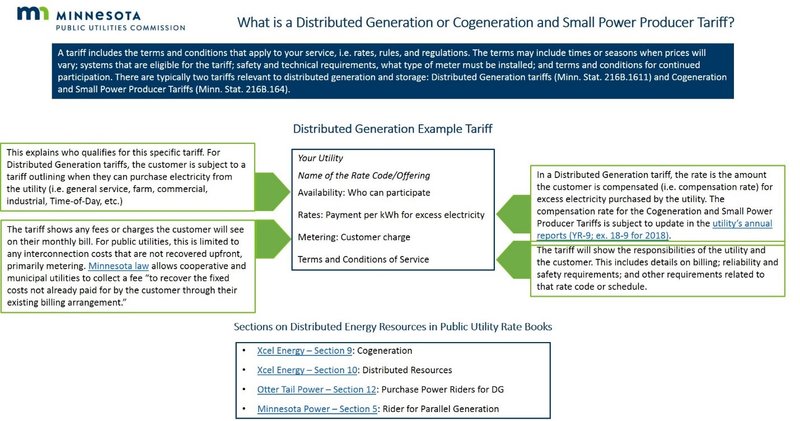The Commission is tasked with ensuring a safe, fair, and reasonable interconnection process between the customer and the utility. We do not regulate the relationship between the customer and the DER developer, installer or the manufacturer of the DER equipment. Our Consumer Affairs Office can direct you to the right resource.
Customers must apply with their utility to have their distributed energy resource (including storage) that operates in parallel with the utility electric grid reviewed for permission to operate connected to the grid. The customer is responsible to make sure the system complies with state and local codes; including electrical codes, building codes, and zoning laws. This is known as the interconnection process. The utility does not provide warranty as to the adequacy, safety, or other characteristics of the distributed energy resource or any related structures, equipment, wires, appliances or devices not owned, installed or maintained by the utility.
The customer will be asked to sign a contract that outlines terms and conditions, rates and fees associated with the interconnection of their Distributed Energy Resource. This may be either the Uniform Statewide Contract or the Minnesota Interconnection Agreement. There are some types of Distributed Energy Resources which do not operate in parallel, and may have different requirements. Minnesota’s statewide technical requirements address this issue [1], and are currently undergoing an update in Docket No. 16-521.
The Minnesota Uniform Statewide Contract applies to all customers with qualifying systems under 40 kilowatt (kW) and public utility customers where certain qualifying systems are under 1 megawatt (MW).
The Minnesota Interconnection Agreement template (see Minnesota Distributed Energy Resource Interconnection Agreement (MN DIA)) applies to all distributed generation systems up to 10 MW not covered by the Minnesota Uniform Statewide Contract, and to certain sized systems under 1 MW that are also covered by the Minnesota Uniform Statewide Contract, that operate in parallel with a Minnesota utility’s electric system. [2]
Utilities keep tariffs [3] (sometimes called rate books) for various services offered to different customer classes; including rate schedules for customers with distributed generation (See the Public Utility Rate Books.) These tariffs include compensation rates for distributed generation production (electricity and, in some cases, capacity) delivered to the utility that are updated annually. Public utilities file their annual tariff updates through the Commission’s eDocket system. The tariffs are filed in the same docket number each year and can be found by entering the year and the docket number “09” . For example, the rates for 2018 can be found in the annual tariff updated filed in Docket No. 18-09, while the rates for 2017 can be found in Docket No. 17-09. These rates are automatically approved 60 days after they are filed unless non-utility stakeholders contest them. Additionally, distributed generation tariffs may be updated with Commission approval to address other changes proposed by the utility or required by state law.

Download a pdf of the DG Tariff explanation with live links.
[1] Minnesota Interconnection Standards apply to parallel operation. There are distributed energy resources that do not operate in parallel (e.x. electric vehicles, back up or standby generators, etc.) National Energy Code still applies in these instances. In addition, there is an active discussion in Docket No. 16-521 about how to address non-exporting or inadvertent exporting Distributed Energy Resources.
[2] Xcel Energy has updated their tariff ( Section 9 ) to allow certified DER under 250 kW that meet certain criteria to use the Uniform Statewide Contract in place of the Minnesota Interconnection Agreement.
[3] A tariff contains the terms and conditions for electrical service, including the cost for electrical service.